
Insects in the family Tettigoniidae are commonly called katydids or bush crickets. They have previously been known as "long-horned grasshoppers". More than 8,000 species are known. Part of the suborder Ensifera, the Tettigoniidae are the only extant (living) family in the superfamily Tettigonioidea.

Orthoptera is an order of insects that comprises the grasshoppers, locusts, and crickets, including closely related insects, such as the bush crickets or katydids and wētā. The order is subdivided into two suborders: Caelifera – grasshoppers, locusts, and close relatives; and Ensifera – crickets and close relatives.

Anostostomatidae is a family of insects in the order Orthoptera, widely distributed in the southern hemisphere. It is named Mimnermidae or Henicidae in some taxonomies, and common names include king crickets in Australia and South Africa, and wētā in New Zealand. Prominent members include the Parktown prawn of South Africa, and the giant wētā of New Zealand.

Forficula auricularia is a species complex comprising the common earwig. It is also known as the European earwig. It is an omnivorous insect belonging to the family Forficulidae. The name earwig comes from the appearance of the hindwings, which are unique in their resemblance to human ears when unfolded. The species name of the common earwig, auricularia, is a specific reference to this feature. The European earwig survives in a variety of environments. It is also a common household insect in North America. They are often considered a household pest because of their tendency to invade crevices in homes and consume pantry foods, though they may also act as beneficial species depending on the circumstances.

Mole crickets are members of the insect family Gryllotalpidae, in the order Orthoptera. Mole crickets are cylindrical-bodied, fossorial insects about 3–5 cm (1.2–2.0 in) long as adults, with small eyes and shovel-like fore limbs highly developed for burrowing. They are present in many parts of the world and where they have arrived in new regions, may become agricultural pests.

Gryllinae, or field crickets, are a subfamily of insects in the order Orthoptera and the family Gryllidae.

Dolbear's law states the relationship between the air temperature and the rate at which crickets chirp. It was formulated by physicist Amos Dolbear and published in 1897 in an article called "The Cricket as a Thermometer". Dolbear's observations on the relation between chirp rate and temperature were preceded by an 1881 report by Margarette W. Brooks, although this paper went unnoticed until after Dolbear's publication.

Tree crickets are insects of the order Orthoptera. These crickets are in the subfamily Oecanthinae of the family Gryllidae.

Oecanthus is a genus of cricket in subfamily Oecanthinae, the tree crickets.
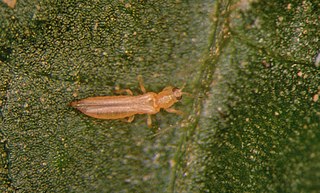
The western flower thrips [Frankliniella occidentalis (Pergande)] is an invasive pest insect in agriculture. This species of thrips is native to the Southwestern United States but has spread to other continents, including Europe, Australia, and South America via transport of infested plant material.
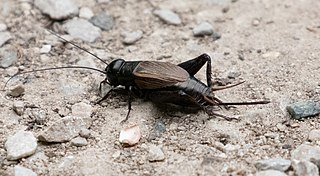
Gryllus veletis, commonly known as the spring field cricket, is abundant throughout eastern North America. G. veletis is a solitary, aggressive, omnivorous, burrow-inhabiting species of cricket. This species is commonly confused with Gryllus pennsylvanicus, as they inhabit the same geographical area. However, the two species are easily distinguished through examination of life history, ovipositor and behavioural differences. Predators of G. veletis include American toads, wild turkeys, red-tailed hawks, wolf spiders and red-backed salamanders.

Crickets are orthopteran insects which are related to bush crickets, and, more distantly, to grasshoppers. In older literature, such as Imms, "crickets" were placed at the family level, but contemporary authorities including Otte now place them in the superfamily Grylloidea. The word has been used in combination to describe more distantly related taxa in the suborder Ensifera, such as king crickets and mole crickets.
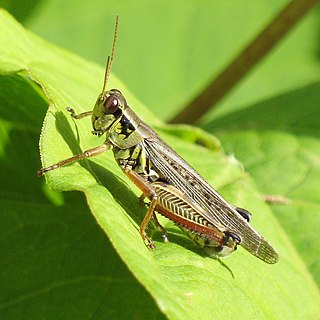
Melanoplus femurrubrum, the red-legged grasshopper, is a species of grasshopper belonging to the genus Melanoplus. It is one of the most common grasshoppers found in Mexico, the United States, and Canada. This grasshopper is frequently used as a model organism in scientific studies, due to their abundance throughout North America and behavioral response to changes in climate.

Oecanthus pellucens, common name Italian tree cricket, is a species of tree crickets belonging to the family Gryllidae, subfamily Oecanthinae.
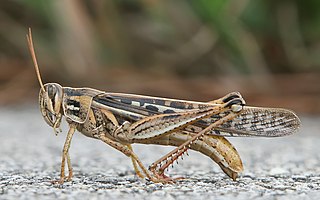
Schistocerca americana is a species of grasshopper in the family Acrididae known commonly as the American grasshopper and American bird grasshopper. It is native to North America, where it occurs in the eastern United States, Mexico, and the Bahamas. Occasional, localized outbreaks of this grasshopper occur, and it is often referred to as a locust, though it lacks the true swarming form of its congener, the desert locust.

Scapteriscus is a genus of insects in the family Gryllotalpidae, the mole crickets. Members of the genus are called two-clawed mole crickets. They are native to South America. Some species have arrived in other regions, including parts of North America, where some have become invasive and have become established as pests.

Anurogryllus arboreus, the common short-tailed cricket or arboreal short-tailed cricket, is a species of cricket in the family Gryllidae. It is native to the southern and south-eastern United States where it lives in a burrow that it digs.

Oecanthus nigricornis is a "common tree cricket" in the subfamily Oecanthinae. A common name for O. nigricornis is black-horned tree cricket. It is found in North America.
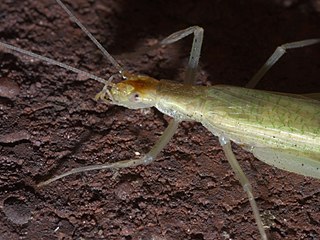
Oecanthus niveus, known generally as the narrow-winged tree cricket or snowy tree cricket, is a species of tree cricket in the family Gryllidae, which includes all crickets. First noted by Swedish Entomologist Charles de Geer in 1773 by a Pennsylvanian Specimen, it is found primarily in Eastern North America south of Canada, and also in the Caribbean.

Oecanthus capensis, the Cape thermometer cricket, is a species of tree cricket. It has been found that the rate at which these crickets chirp follows Dolbear's law.



















